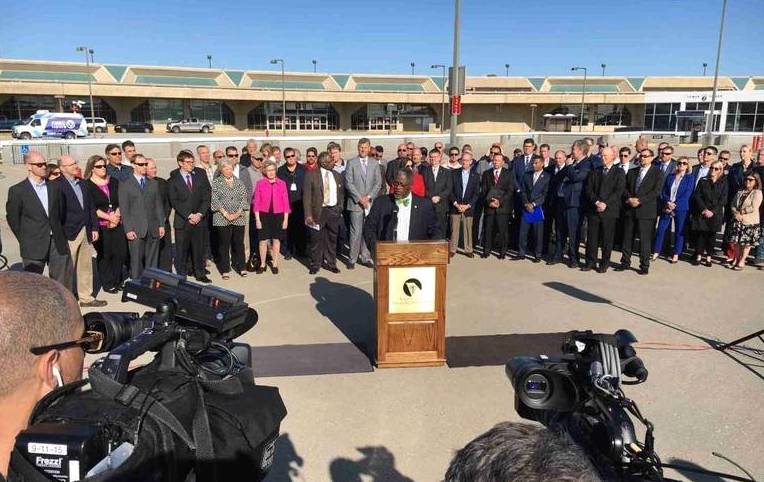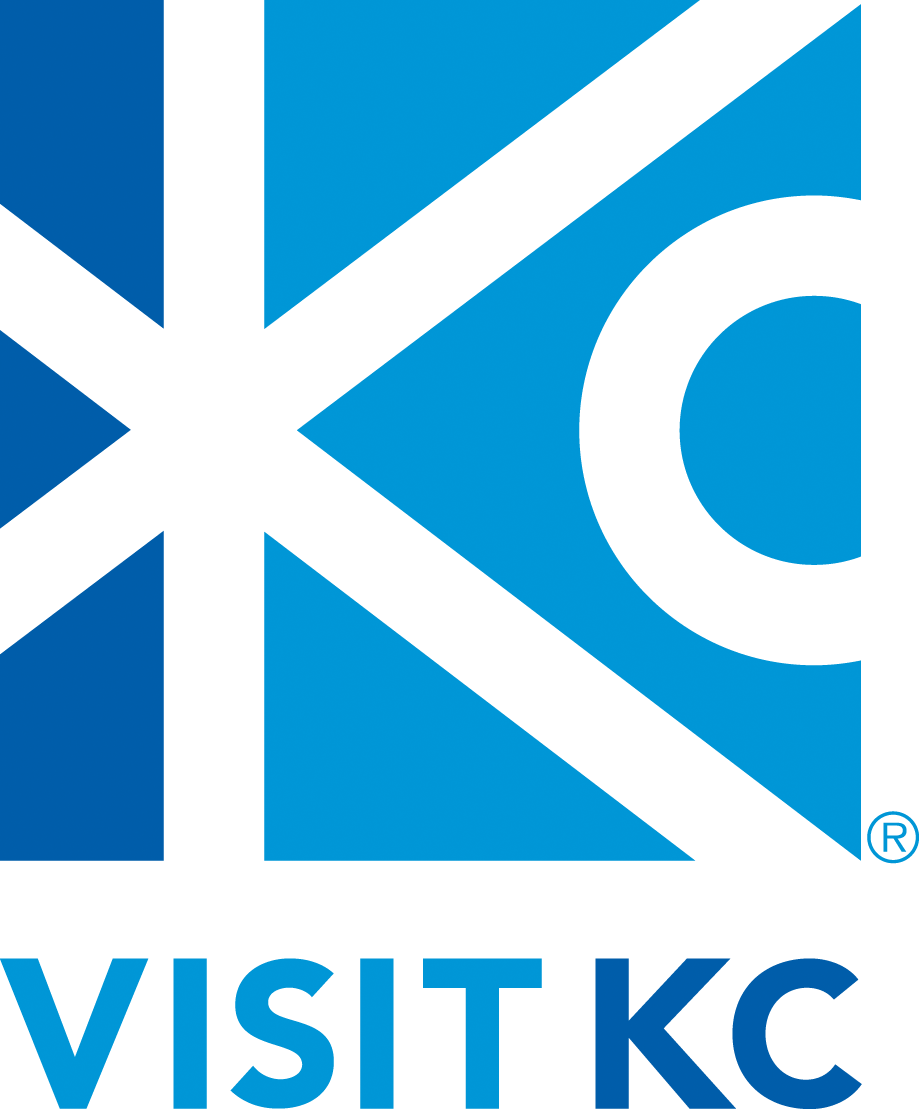The media show yesterday at Kansas City International Airport was impressive. Especially for how they were able to get that many people in suits and dresses for a “hastily-called” press conference. The main topic of course, was the proposal from Burns & McDonell to privately finance a new single terminal at KCI.
The mayor’s sales pitch can be summarized by saying that since the city is now guaranteed no financial risk, the project can finally move forward. I must respectfully disagree that “financing” was a major issue to begin with. Opponents of a new single-terminal have been more concerned about convenience issues, loss of security advantages per TSA by going to a single checkpoint, rising costs to airlines and passengers, etc..
The push-back on financing was in response to the claim that the “airlines are paying for it.” This mantra has been repeated over and over as if the airlines are getting together and writing a check each year to pay off our bond debt. In reality, they agreed to pay increased rent that would cover most of the anticipated debt load during the term of their lease. However, the lease term is not as long as the bond term and is subject to renegotiation. Thus, while there is a clause that if an airline pulled out of KCI, the remaining airlines will make up the difference, there is nothing to prevent others from pulling out under the burden of increased costs and/or renegotiating the lease to keep them here while the airport covers the debt.
I find it interesting that for over a year we heard that there was no risk to airport bondholders and taxpayers with the “airlines paying for it” but then yesterday, the Star quoted the mayor and Burns & McDonnell as saying:
The advantage of this plan, according to company representatives and Mayor Sly James, is that Kansas City would issue no bonds and bear no taxpayer risk if the airport failed to generate the revenues needed to pay off the construction and other costs, including overruns.
So are we finally admitting that there IS some risk under the airline lease agreement? Just curious.
Other questions that come to mind are these:
- Why is there no collaboration with the incredible design resources of our architectural community? Apart from Populous, HNTB, and a host of other globally recognized firms, the exclusion of BNIM and it’s founder Bob Berkebile is a particular slight. Besides being on the original KCI design team, he invested a couple of years of his life co-leading the mayor’s airport task force.
- It’s said that the annual debt load will be capped at the originally planned $85.2 million, but that this plan will carry a higher interest rate due to the difference between public and private financing. That means the project itself must cost less. The construction term for this is “value engineering.” This means cheaper materials, removal of features or the contractor eats it. Which of these options is chosen depends on who has the final word on these matters. Who gets to decide?
- There was talk yesterday of 35 gates. When a single terminal was originally proposed in 2013, it was 37 gates. KCI as it currently exists has a capacity for nearly double that amount. A high-ranking airline official told me in 2013, we’ve never seen a city spend a billion dollars to downsize. Based on current growth projections, the desire to expand international traffic, and the “build it and they will come” promise of several new flights from Southwest who cannot use flexible gates, how many gates will we need before a new terminal will be paid off? Since we’ll be maxing out our debt capacity, we likely won’t be able to borrow more for an “expansion project” for years.
- There is still talk that part of the debt will be paid by increased parking fees and concessions. (aka paid by taxpayers but why digress into semantics?) What is NOT being discussed is how big that piece needs to be and how we get there. In 2014 I wrote a post about KCI retail and unrealistic expectations. For some reason, the concession operators were dropped from the mayor’s task force agenda. To this day, I have yet to read of anyone asking the current concession operator for projections. Or have they and whoever asked did did not like the answer. The only way to boost retail revenue at KCI is to increase the amount of time people are forced to hang-out there. What are the projected parking increases and can we see the projections from our concession operator and what those are based on?
- The idea of a public/private collaboration is a good one that has been suggested before. The REAL success of the Dallas Love Field project was the fact that Southwest managed it instead of the city of Dallas, saving hundreds of millions of dollars. Now that we have finally crossed this line, can we explore other partnerships based in part on open competition between engineering and design firms as well as others including airlines who might want to invest in the future of this asset? Perhaps there is a way to dramatically reduce the costs and risks while improving the product that would make going to a public financing model and a lower interest rate the better option.
-
How long has this proposal been in the works? There seem to be a lot of pieces in place for only a couple of weeks. If it’s a fresh idea, then I can understand why a larger, more collaborative team has not been put together. It appears though that such was never the intention.
- In all the articles I’ve read about this, I have not seen a single quote from Southwest or any other airline. In 2013, one of the huge blunders the city made was not including the airlines in the process. When were they looped in to this and why are they not at the podium?
- Speaking of quotes, one last question with tongue planted firmly in cheek: The Kansas City Star reported that
With Friday’s announcement, James said, Burns & McDonnell and the city have come forward with “a Kansas City solution for a Kansas City problem.”
However, a press release from Burns & McDonnell said that:
Burns & McDonnell is committed to investing in the city we all love and provide a creative Kansas City solution to a Kansas City challenge,” says Ray Kowalik, Chairman and CEO, Burns & McDonnell.
I’m just curious who said it first.
(Photo at top courtesy: The Kansas City Star)






Hey, Kevin – thanks for your perspective. Couple of thoughts/comments…
* The collaboration piece is interesting. However, as far as I can tell B&M approached the city with their plan (investing time and money) not vice versa. Do you think other firms would be willing to take such a financial risk? Perhaps the city council will bring that up as question? However, we do have a great bunch of companies in town it would be nice to see them collaborate.
* Agreed on the “value engineering”. Certainly don’t want to take any shortcuts on design/build given it is such an important piece of infrastructure.
* I am hopeful the studies, etc will show that we need X number of gates whether it is 35 or 37, etc. We certainly don’t need 65+ which is what I believe we had when A was open. The build it and they will come argument is a popular one but in the aviation industry anything can happen and nothing is guaranteed (this argument is one that the city likes to use but would prefer they don’t as it is short sighted).
*If the city stuck with issuing bonds, this information would have to be disclosed in the bond issuing paperwork. If the B&M proposal sticks, I would imagine they too would have to pin a number to it but since it is private I am not sure they would be obligated to share?
* Agree with you on the public/private component. It would be nice if there were other players involved. Also, what happens if B&M files for bankruptcy half-way through construction? (long shot but what if)?
* I thought the airlines were being briefed about this on Friday the 12th? It will be interesting to see how they respond
I thought for a brief wonderful moment last year when the mayor put this whole project on hold, that this madness would just slip away into the ether. Apparently not. It’s a clear case of a solution in search of a problem. Everybody LOVES the airport just the way it is. Why are we even talking about whether or not the financing is feasible, and who cares who’s involved in planning this nonsense? The point to focus on is that we need to mobilize the masses, the people who use the airport, to stand in solidarity against this whole crazy, wasteful, counterproductive idea. Let’s keep KCI as it is!
Doug – you will have that opportunity in November (allegedly). When the city will allow all KCMO residents to vote on whether or not they want something done with the airport.
Doug, you’ve posted before that everyone loves KCI, and you’ve been provided evidence that you’re simply wrong. But I’ll do it again.
A few rating websites disagree with your perspective:
http://www.airlinequality.com/airport-reviews/kansas-city-airport/
http://www.worldairportawards.com/awards/world_airport_rating.html
http://www.aci.aero/Airport-Service-Quality/ASQ-Awards/Current-Winners/Best-Airport-By-Region/North-America
https://www.google.com/search?q=kansas+city+aip&oq=kansas+city+aip&aqs=chrome..69i57j0l5.2356j0j4&sourceid=chrome&ie=UTF-8#q=kansas+city+airport&lrd=0x87c05e0888e68799:0xc3cdd0195d2edaa0,1,
https://www.yelp.com/biz/kansas-city-international-airport-kansas-city-5
http://www.jdpower.com/press-releases/2016-north-america-airport-satisfaction-study
18% of people who live in Kansas City use the airport. This is not “the masses”. Ask anyone who flies through KC about how the airport compares to other cities. It’s embarrassing. Also, number of flights per day per gate is embarrassingly low…something around 4. Most other airports average in the 6-7 range, and the airlines think 10 is the max number of flights achievable per gate per day. More efficient use of 35 gates negates the need for more gates that will sit underutilized. The City Council deciding that the residents of KC get to vote on things that happen at an the airport is almost unheard of in other cities. Check out what is going on at LaGuardia. That’s a $10B project. This KCI project is a big project, but it is not uncommon. Stop painting it with so much negativity.
If they need a new terminal, why can’t they build it on some of the 1000’s of vacant acres they own up there? It looks like they want to build a shopping mall with airport thrown in. I like KCI the way it is.
Allen – the city already determined that building a new terminal in a different part of the airfield would be far too expensive (new roads/interchanges with 152, etc).
I haven’t seen any shopping mall renderings but would appreciate a link if you have it.
This is not cheaper – with Burns & Mac dictating the price, it has now doubled to $2.5 billion.
http://www.bizjournals.com/kansascity/news/2017/05/12/burns-and-mcdonnell-new-kci-terminal-proposal.html?ana=e_ae_set1&s=article_du&ed=2017-05-12&u=nBiE3aPQDoj%2FkoIJqR25GGg8r0D&t=1494697566&j=78159571
Josh – the Burns&Mac plan price includes the interest as well. I don’t think it has doubled necessarily.
Quote from article:
The Burns & McDonnell plan calls for a $3 to $4 increase in airport user fees, Schulte added, but the airlines already have approved that increase.
The City’s previous plan, when including interest, overrun accounts, etc., was going to be $1.2 billion. This plan is now double that.
Quote from article:
City Manager Troy Schulte said the cost of the improvements, including interest, would be about $2.5 billion. To repay the project financing, the MOU requires the airlines to pay an amount that, together with federal grants and other potential funding sources, would total approximately $85.2 million a year for 30 years.
From Steve Vockrodt’s story in The Pitch, May 3, 2016:
When the recommended concept was floated a week ago, it was described as a $964 million project. But the true cost was right back again at $1.2 billion, once financing charges and interest were entered into the equation.
I am still not sure I follow that the cost has doubled. While it is higher, I don’t believe it is twice as much as that would seem like a bad deal.
The B&M proposal would ask airlines to pay 85.2 million for 30 years.
The original proposal from last year would ask the airlines to pay 69.33 million for 30 years.
If you calculate the basic math between the two proposals, it is roughly 476 million dollars more for B&M.
Which obviously is still a lot of money at the end of the day
Some people just like to complain, don’t they Kevin? I get it, though. You and this site can’t stay relevant if you don’t have something to complain about.
Where am I complaining? In fact, I’ve said I thought a public/private partnership is a good idea. I’m simply asking what I think are important questions, and pointing out inconsistencies in an effort to find the truth – a commodity that most would agree has been unnecessarily absent from this issue (ok, you can call that last comment a complaint.) I would love for this site to no longer be relevant. I have a job and a family and this site takes me away from both. But until someone else (hello news media) starts asking these questions, I’ll keep doing so.
Have you reached out to Burns &McDonnell’s CEO, Ray Kowalik, or anyone else closely involved in the project, or just complained that you don’t know enough about what is going on from the background? Ray is a great guy, I’m sure he will be willing to answer your questions if you ask him.